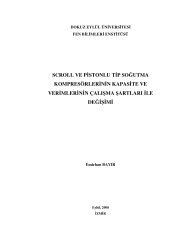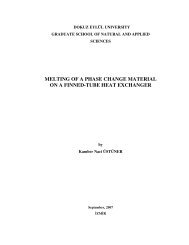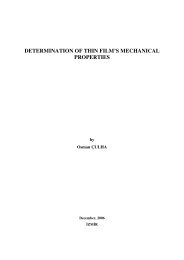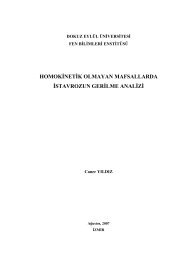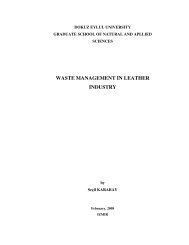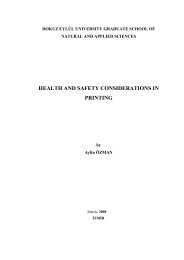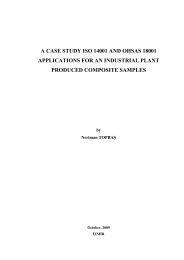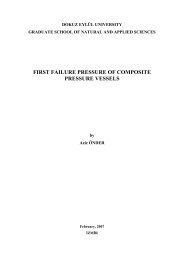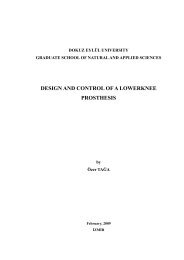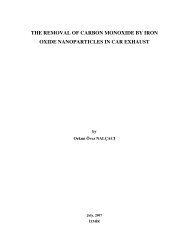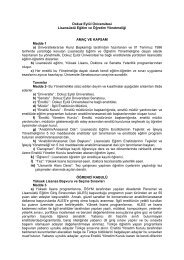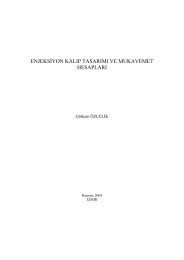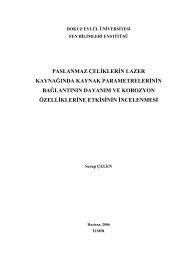computer aided design and optimization of heat exchangers
computer aided design and optimization of heat exchangers
computer aided design and optimization of heat exchangers
Create successful ePaper yourself
Turn your PDF publications into a flip-book with our unique Google optimized e-Paper software.
COMPUTER AIDED DESIGN AND OPTIMIZATION<br />
OF HEAT EXCHANGERS<br />
by<br />
Bayram IRMAKLIOĞLU<br />
June, 2006<br />
İZMİR
COMPUTER AIDED DESIGN AND OPTIMIZATION OF HEAT EXCHANGERS<br />
ABSTRACT<br />
In this study, a two-row aluminum plate fin <strong>and</strong> copper tube blast freezer evaporator is<br />
analyzed for different geometrical parameters, numerically. The effects <strong>of</strong> fin pitch, fin<br />
thickness, fin material, tube diameter, longitudinal <strong>and</strong> transverse tube pitches on <strong>heat</strong> transfer<br />
<strong>and</strong> pressure drop are investigated in 14 different geometrical models for actual boundary<br />
conditions <strong>and</strong> turbulent flow by using a CFD s<strong>of</strong>tware (Fluent). Numerical results are<br />
compared with theoretical results; it is observed that the numerical results are in good<br />
agreement with the theoretical results.<br />
Keywords: Heat exchanger, evaporator, numerical, Fluent<br />
ISI DEĞİŞTİRGEÇLERİNİN BİLGİSAYAR DESTEKLİ TASARIMI VE<br />
OPTİMİZASYONU<br />
ÖZ<br />
Bu çalışmada, iki sıralı alüminyum kanatlı ve bakır borulu bir şoklama evaporatörü,<br />
değişik geometrik parametreler için nümerik olarak analiz edilmiştir. Kanat aralığı, kanat<br />
kalınlığı, kanat malzemesi, boru çapı, yatay ve dikey boru aralıklarının ısı transferi ve basınç<br />
düşümüne etkisi 14 değişik geometrideki modelde gerçek sınır şartları ve türbülanslı akış için,<br />
bir CFD yazılımı olan Fluent kullanılarak incelenmiştir. Nümerik sonuçlar, teorik sonuçlarla<br />
karşılaştırılmış; nümerik sonuçların teorik sonuçlarla uyum içerisinde olduğu gözlenmiştir.<br />
Anahtar sözcükler: Isı değiştirgeci, evaporatör, nümerik, Fluent.<br />
1. Introduction<br />
The process <strong>of</strong> <strong>heat</strong> exchange between two fluids that are at different temperatures <strong>and</strong><br />
separated by a solid wall occurs in many engineering applications. The device used to<br />
implement this exchange is termed a <strong>heat</strong> exchanger, <strong>and</strong> specific applications may be found<br />
in space <strong>heat</strong>ing <strong>and</strong> air-conditioning, refrigeration systems, power production, waste <strong>heat</strong>
ecovery, <strong>and</strong> chemical processing (Incropera, 2002). Boilers, evaporators, super <strong>heat</strong>ers,<br />
condensers, <strong>and</strong> coolers are all considered <strong>heat</strong> <strong>exchangers</strong>.<br />
Fin <strong>and</strong> tube <strong>heat</strong> <strong>exchangers</strong> are used extensively in various industrial applications. A<br />
number <strong>of</strong> experimental <strong>and</strong> numerical studies on <strong>heat</strong> transfer <strong>and</strong> pressure drop for fin <strong>and</strong><br />
tube <strong>heat</strong> <strong>exchangers</strong> are presented in the literature. Shepherd (1956) studied the <strong>heat</strong> transfer<br />
characteristics <strong>of</strong> a single row aluminum fin <strong>and</strong> tube <strong>heat</strong> exchanger, experimentally. Rich<br />
(1973, 1975) investigated the effects <strong>of</strong> both fin pitch <strong>and</strong> the number <strong>of</strong> tube rows on the air<br />
side <strong>heat</strong> transfer <strong>and</strong> pressure drop for plate fin <strong>and</strong> tube <strong>heat</strong> <strong>exchangers</strong>. Saboya & Sparrow<br />
(1974, 1976a, 1976b) studied <strong>heat</strong> transfer characteristics <strong>of</strong> one, two, <strong>and</strong> three-row fin <strong>and</strong><br />
tube <strong>heat</strong> exchanger configurations. Elmahdy & Biggs (1979) developed an empirical<br />
technique to predict air side Colburn factor based on the Reynolds number. Eight-row coils<br />
with circular or continuous plate fins <strong>and</strong> circular tubes were used in the experiment. Gray &<br />
Webb (1986) developed correlations for air side <strong>heat</strong> transfer coefficient <strong>and</strong> friction factor as<br />
a function <strong>of</strong> the Reynolds number <strong>and</strong> the geometrical parameters. The results were<br />
applicable to any number <strong>of</strong> tube rows. Wang et al. (1996 – 2001) studied the effects <strong>of</strong><br />
number <strong>of</strong> tube rows, tube diameter, fin pitch, <strong>and</strong> fin thickness on <strong>heat</strong> transfer <strong>and</strong> pressure<br />
drop characteristics for different fin surfaces.<br />
Turaga et al. (1988) studied plate fin <strong>and</strong> tube direct expansion <strong>heat</strong> exchanger refrigerant<br />
air cooling <strong>and</strong> dehumidifying <strong>heat</strong> <strong>exchangers</strong>, to determine the effects <strong>of</strong> the geometric <strong>and</strong><br />
the fluid flow parameter on coil performance. Horuz et al. (1998) analyzed the theoretical <strong>and</strong><br />
experimental performance <strong>of</strong> air-cooled evaporators. Abu Madi et al. (1998) tested 28 <strong>heat</strong><br />
exchanger samples in an open circuit thermal wind tunnel for different geometries. Kim &<br />
Kim (2005) developed a <strong>heat</strong> transfer correlation to be used in the optimal <strong>design</strong> <strong>of</strong><br />
evaporators for refrigerators <strong>and</strong> freezers.<br />
Rosman et al. (1984) performed a numerical two-dimensional <strong>heat</strong> transfer analysis for<br />
plate fin <strong>and</strong> tube <strong>heat</strong> <strong>exchangers</strong> in order to obtain fin efficiency. Jang et al. (1996)<br />
investigated the effects <strong>of</strong> different geometrical parameters on the average <strong>heat</strong> transfer<br />
coefficient <strong>and</strong> pressure drop for plate fin <strong>and</strong> tube <strong>heat</strong> <strong>exchangers</strong>, numerically <strong>and</strong><br />
experimentally. Rocha et al. (1997) studied fin efficiency for elliptical tubes. Jang & Chen<br />
(1997) investigated wavy fin <strong>and</strong> tube <strong>heat</strong> <strong>exchangers</strong>. Jang et al. (1998) studied fluid flow<br />
<strong>and</strong> <strong>heat</strong> transfer characteristics over circular fin <strong>and</strong> tube <strong>heat</strong> <strong>exchangers</strong> with staggered
arrangement. Mendez et al. (2000) investigated the effects <strong>of</strong> fin pitches on a single-row fin<br />
<strong>and</strong> tube <strong>heat</strong> exchanger. Shih (2003) performed a numerical simulation on predicting the<br />
pressure drop <strong>and</strong> <strong>heat</strong> transfer coefficient for the evaporator <strong>of</strong> domestic refrigerator. Mon &<br />
Gross (2004) investigated annular fin <strong>and</strong> tube <strong>heat</strong> <strong>exchangers</strong>.<br />
In this study, a two-row plate fin <strong>and</strong> tube blast freezer evaporator model is analyzed for<br />
different geometrical parameters, numerically. The evaporator is used in fish freezing process<br />
at -25°C. The geometrical parameters are taken from commercially available products. The<br />
effects <strong>of</strong> fin pitch, fin thickness, fin material, tube diameter, longitudinal <strong>and</strong> transverse tube<br />
pitch on the air side <strong>heat</strong> transfer <strong>and</strong> pressure drop <strong>of</strong> aluminum plate fin <strong>and</strong> staggered tube<br />
<strong>heat</strong> <strong>exchangers</strong> are investigated for actual boundary conditions <strong>and</strong> turbulent flow. R404A is<br />
used as refrigerant. The air inlet velocity ranges from 2 m/s to 4 m/s.<br />
2. Theoretical Study<br />
The blast freezer evaporator shown in Figure 1 is used in fish freezing at -25°C in a spiral<br />
belt freezer tunnel. Freezing capacity is 250 kg/h. There are 6 suction fans to suck ambient air<br />
at -25°C <strong>and</strong> pass through the tubes <strong>and</strong> fins which have a surface temperature <strong>of</strong> -30°C <strong>and</strong><br />
blow again to the ambient. Fin geometry is shown in Figure 2. Technical data <strong>of</strong> the<br />
evaporator is given in Table 1.<br />
Figure 1. Blast freezer evaporator
Figure 2. Fin geometry<br />
Table 1. Technical data <strong>of</strong> the evaporator<br />
Transverse pitch (S T ) 38.1 mm<br />
Longitudinal pitch (S L ) 66 mm<br />
Tube diameter 5/8”<br />
Freezing process<br />
F<br />
Staggered tube arrangement S<br />
Number <strong>of</strong> tubes in one row 54T<br />
Number <strong>of</strong> tube rows 6R<br />
Total fin length<br />
1600A<br />
Fin pitch 8.00P<br />
Number <strong>of</strong> circuit<br />
27 NC<br />
Fin material<br />
Aluminum<br />
Tube material<br />
Copper<br />
Tube outer diameter 16.65 mm<br />
Tube inner diameter 15.85 mm<br />
Air mass flow rate<br />
28597 m³/h<br />
Air inlet velocity<br />
2.41 m/s<br />
Air inlet temperature -25°C<br />
Air inlet relative humidity 95%<br />
Air outlet temperature -27.31°C<br />
Air outlet relative humidity 100%<br />
Refrigerant<br />
R404A<br />
Mass flow rate<br />
1114 kg/h<br />
Velocity (gas phase) 5.39 m/s<br />
Velocity (liquid phase) 0.0463 m/s<br />
Evaporation temperature -30 °C<br />
Condensation temperature 40°C
2.1 Heat Transfer Calculation<br />
Since the evaporator is a <strong>heat</strong> exchanger, one <strong>of</strong> the <strong>heat</strong> transfer <strong>and</strong> pressure drop<br />
calculation methods, LMTD (Logarithmic Mean Temperature Difference) method is used in<br />
this study. Total <strong>heat</strong> transfer capacity is calculated from Eq. 1 (Kakaç, 1998),<br />
Q U<br />
o<br />
Ao<br />
ΔTlm<br />
= U<br />
o<br />
Ao<br />
FΔTlm,<br />
cf<br />
= (1)<br />
Q : Heat transfer capacity (W)<br />
U o : Overall <strong>heat</strong> transfer coefficient (W/m²K)<br />
A o : Total outside <strong>heat</strong> transfer area (m²)<br />
F : Correction factor for cross flow<br />
∆T lm,cf : Average logarithmic temperature difference for cross flow (°C)<br />
∆T lm : Average logarithmic temperature difference for counter flow (°C)<br />
Overall <strong>heat</strong> transfer coefficient is calculated from Eq. 2 (Kays & London, 1984),<br />
U<br />
o<br />
⎡ Ao<br />
= ⎢<br />
⎢⎣<br />
hi<br />
Ai<br />
tw<br />
A<br />
+<br />
k A<br />
w<br />
o<br />
pm<br />
+<br />
h<br />
o<br />
o<br />
( A + η A )<br />
to<br />
A<br />
f<br />
f<br />
⎤<br />
⎥<br />
⎥⎦<br />
−1<br />
(2)<br />
A i : Tube inside surface area (m²)<br />
h i : Refrigerant side <strong>heat</strong> transfer coefficient (W/m²K)<br />
t w : Tube thickness (m)<br />
k w : Tube conduction coefficient (W/mK)<br />
A pm : Tube <strong>heat</strong> transfer area depending on average tube diameter (m²)<br />
h o : Air side <strong>heat</strong> transfer coefficient (W/m²K)<br />
A to : Tube outside surface area (m²)<br />
A f : Finned <strong>heat</strong> transfer area (m²)<br />
η f : Fin efficiency<br />
Air side Nusselt number is calculated from Eq. 3 (VDI-Heat Atlas, 1993),<br />
= 0.38Re<br />
Pr<br />
1<br />
3<br />
⎛ A<br />
⎜<br />
⎝ A<br />
⎞<br />
⎟<br />
⎠<br />
−0.15<br />
0.6<br />
o<br />
Nu (3)<br />
to
Air side <strong>heat</strong> transfer coefficient is calculated from Eq. 4 (Kakaç, 1998),<br />
h<br />
Nu.<br />
k<br />
a<br />
o<br />
= (4)<br />
d<br />
o<br />
h o = 60.43 W/m²K<br />
Refrigerant side <strong>heat</strong> transfer coefficient is calculated from Eq. 5 (Kakaç, 1991),<br />
h<br />
h<br />
tp<br />
l<br />
C2<br />
C5<br />
C4<br />
( Co) ( Frl<br />
) C3<br />
( Bo) F<br />
fl<br />
= C1 25 +<br />
(5)<br />
Assuming refrigerant is saturated liquid only, <strong>heat</strong> transfer coefficient is calculated from<br />
Eq. 6 (Kakaç, 1991),<br />
h<br />
l<br />
=<br />
⎛ G<br />
⎜<br />
( 1−<br />
x)<br />
d<br />
⎞<br />
0 i<br />
.023⎜<br />
⎟ ⎝ μl<br />
⎠<br />
0.8<br />
0.4<br />
Pr k<br />
d<br />
i<br />
l<br />
(6)<br />
h l = 41.17W/m 2 K<br />
h i = h tp = 796.8 W/m²K<br />
U o = 23.56 W/m 2 K<br />
Q = 27.39 kW<br />
2.2 Pressure Drop Calculation<br />
Air side pressure drop is calculated from Eq. 7 (Kakaç, 1998),<br />
2<br />
G ⎡ A<br />
⎤<br />
t<br />
ρi<br />
2<br />
⎛ ρi<br />
⎞<br />
∆P = ( ) ⎜ ⎟⎥ ⎦<br />
⎢ f<br />
2ρi<br />
⎣ A<br />
min<br />
+ 1+<br />
σ ⎜<br />
−1<br />
ρ<br />
⎟<br />
⎝ ρ<br />
o ⎠<br />
(7)<br />
ΔP = 64.16 Pa
Refrigerant side pressure drop is calculated from Eq. 8 (Kakaç, 1998),<br />
f<br />
ΔP<br />
= <br />
2<br />
4( L / d i<br />
)( ρu m<br />
/ 2)<br />
2<br />
L ρum<br />
Δ P = 4 f<br />
(8)<br />
d 2<br />
i<br />
ΔP = 3.57 kPa<br />
3. Numerical Study<br />
The studied model consists <strong>of</strong> two fins with half fin thickness, two half fin tube <strong>and</strong> air<br />
between fins. Due to the symmetry, minimum segment <strong>of</strong> the fin is modeled. Symmetrical<br />
condition <strong>of</strong> the model is shown in Figure 3. Two-row model is considered as shown in<br />
Figure 4.<br />
Figure 3. Symmetrical condition <strong>of</strong> the model<br />
Figure 4. Two-row model
Vertexes, edges, faces, <strong>and</strong> volumes are created <strong>and</strong> meshed, respectively. Four hexahedral<br />
finite volume elements along the thickness <strong>of</strong> the half fin <strong>and</strong> ten hexahedral finite volume<br />
elements along the distance between two fins are used as shown in Figure 5.<br />
Figure 5. Volume mesh<br />
Velocity inlet boundary condition is defined for bottom surface, since air enters from that<br />
cross section. The air exits from the top side <strong>of</strong> the model. So, the outflow boundary condition<br />
is given to this surface. Symmetrical boundary conditions are given to the side, front <strong>and</strong> back<br />
surfaces <strong>of</strong> the model due to the symmetry. Tube inner surfaces are defined as wall, since<br />
convection <strong>heat</strong> transfer occurs from these surfaces.<br />
3D version <strong>of</strong> the Fluent is selected in order to analyze <strong>heat</strong> transfer <strong>and</strong> pressure drop. The<br />
flow is assumed to be steady <strong>and</strong> incompressible. St<strong>and</strong>ard k-epsilon turbulence model<br />
selected because <strong>of</strong> high flow velocity <strong>and</strong> Reynolds number.<br />
After solution is converged; temperature <strong>and</strong> pressure contours, velocity vectors can be<br />
displayed for visual consideration <strong>of</strong> the results. The temperature <strong>and</strong> pressure contours <strong>of</strong> 14<br />
different models for air inlet velocity <strong>of</strong> 2.41 m/s are shown in Figure 22 <strong>and</strong> Figure 23. The<br />
velocity vectors for the same condition are shown in Figure 24. Total <strong>heat</strong> transfer rate is<br />
calculated from flux reports. Pressure drop is calculated from surface integrals.
4. Results <strong>and</strong> Discussions<br />
The blast freezer evaporator models are analyzed for different geometrical parameters<br />
shown in Table 2, numerically. The geometrical parameters are taken from commercially<br />
available products. The effects <strong>of</strong> fin pitch, fin thickness, fin material, tube diameter,<br />
longitudinal <strong>and</strong> transverse tube pitch on the air side <strong>heat</strong> transfer <strong>and</strong> pressure drop <strong>of</strong><br />
aluminum plate fin <strong>and</strong> staggered tube <strong>heat</strong> <strong>exchangers</strong> are investigated for actual boundary<br />
conditions, turbulent flow <strong>and</strong> blast freezing process.<br />
Table 2. Geometrical parameters <strong>of</strong> the models<br />
Model P T (mm) t (mm) d o (inch) S L (mm) S T (mm)<br />
A 8 0.15 5/8 66 38.1<br />
B 10 0.15 5/8 66 38.1<br />
C 12 0.15 5/8 66 38.1<br />
D 8 0.12 5/8 66 38.1<br />
E 8 0.15 1/2 66 38.1<br />
F 8 0.15 3/8 66 38.1<br />
G * 8 0.15 5/8 66 38.1<br />
H 8 0.15 5/8 66 40<br />
I 8 0.15 5/8 66 31.75<br />
J 8 0.15 5/8 34.64 38.1<br />
K 8 0.15 5/8 33 38.1<br />
L 8 0.15 5/8 27.5 38.1<br />
M 8 0.15 5/8 22 38.1<br />
N ** 8 0.15 5/8 66 38.1<br />
* Aligned tube arrangement<br />
** Fin material is copper<br />
P T : Fin pitch<br />
t : Fin thickness<br />
d o : Tube outside diameter<br />
S L : Longitudinal tube pitch<br />
S T : Transverse tube pitch
4.1 Fin Pitch Effect<br />
Heat Transfer Rate (W)<br />
50000<br />
45000<br />
40000<br />
35000<br />
30000<br />
25000<br />
20000<br />
15000<br />
A(8mm) B(10mm) C(12mm)<br />
2,0 2,41 2,8 3,2 3,6 4,0<br />
V (m/s)<br />
Figure 6. Effects <strong>of</strong> fin pitch on <strong>heat</strong> transfer rate<br />
In Figure 6, the effect <strong>of</strong> fin pitch on the <strong>heat</strong> transfer rate can be clearly seen at higher air<br />
inlet velocities; the <strong>heat</strong> transfer rate is much higher for a small fin pitch than for a larger fin<br />
pitch. However, at low air inlet velocities, there is almost no effect <strong>of</strong> fin pitch on the <strong>heat</strong><br />
transfer rate. The numerical results obtained in this study are in good agreement with the<br />
experimental results in the literature (Horuz et al., 1998).<br />
230<br />
Pressure Drop (Pa)<br />
180<br />
130<br />
80<br />
30<br />
A(8mm) B(10mm) C(12mm)<br />
2,0 2,41 2,8 3,2 3,6 4,0<br />
V (m/s)<br />
Figure 7. Effects <strong>of</strong> fin pitch on pressure drop<br />
Figure 7 shows that the pressure drop increases with increasing air inlet velocities over the<br />
range <strong>of</strong> examined air inlet velocities. Since the turbulence intensity decreased, lower pressure<br />
drop values are obtained when the fin pitch is increased.
4.2 Fin Thickness Effect<br />
50000<br />
45000<br />
Heat Transfer Rate(W)<br />
40000<br />
35000<br />
30000<br />
25000<br />
20000<br />
15000<br />
A(0.15mm)<br />
D(0.12mm)<br />
2,0 2,41 2,8 3,2 3,6 4,0<br />
V (m/s)<br />
Figure 8. Effects <strong>of</strong> fin thickness on <strong>heat</strong> transfer rate<br />
Figure 8 shows that decreasing fin thickness, as in Model D, slightly increases <strong>heat</strong><br />
transfer rate. Heat transfer rate increases with increasing air inlet velocity.<br />
230<br />
Pressure Drop (Pa)<br />
180<br />
130<br />
80<br />
30<br />
A(0.15mm)<br />
D(0.12mm)<br />
2,0 2,41 2,8 3,2 3,6 4,0<br />
V (m/s)<br />
Figure 9. Effects <strong>of</strong> fin thickness on pressure drop<br />
As shown in Figure 9, the fin thickness has no significant effect on the pressure drop.<br />
Pressure drop linearly increases when the air inlet velocity increases.
4.3 Tube Diameter Effect<br />
50000<br />
45000<br />
A(5/8") E(1/2") F(3/8")<br />
Heat Transfer Rate (W)<br />
40000<br />
35000<br />
30000<br />
25000<br />
20000<br />
15000<br />
2,0 2,41 2,8 3,2 3,6 4,0<br />
V (m/s)<br />
Figure 10. Effects <strong>of</strong> tube diameter on <strong>heat</strong> transfer rate<br />
From the Figure 10, the tube diameter is found to have a considerable effect on <strong>heat</strong><br />
transfer rate for different geometrical models. As the tube diameter increases, <strong>heat</strong> transfer<br />
increases with the air inlet velocity.<br />
230,0<br />
A(5/8") E(1/2") F(3/8")<br />
Pressure Drop (Pa)<br />
180,0<br />
130,0<br />
80,0<br />
30,0<br />
2,0 2,41 2,8 3,2 3,6 4,0<br />
V (m/s)<br />
Figure 11. Effects <strong>of</strong> tube diameter on pressure drop<br />
In Figure 11, numerical results reveal that tube diameter has a significant effect on the<br />
pressure drop. The air side pressure drop decreases with a reduction <strong>of</strong> the tube diameter. The<br />
numerical results obtained in this study are in good agreement with the experimental results in<br />
the literature (Wang & Chi, 2000).
4.4 Tube Arrangement Effect<br />
50000<br />
45000<br />
A(Staggered)<br />
G(Aligned)<br />
Heat Transfer Rate (W)<br />
40000<br />
35000<br />
30000<br />
25000<br />
20000<br />
15000<br />
2,0 2,41 2,8 3,2 3,6 4,0<br />
V (m/s)<br />
Figure 12. Effects <strong>of</strong> tube arrangement on <strong>heat</strong> transfer rate<br />
As shown in Figure 12, the staggered tube arrangement improves <strong>heat</strong> exchanger<br />
performance more than 30% compared to the aligned tube arrangement.<br />
230<br />
Pressure Drop (Pa)<br />
180<br />
130<br />
80<br />
30<br />
A(Staggered)<br />
G(Aligned)<br />
2,0 2,41 2,8 3,2 3,6 4,0<br />
V (m/s)<br />
Figure 13. Effects <strong>of</strong> tube arrangement on pressure drop<br />
Figure 13 shows that the effects <strong>of</strong> tube arrangement depending on the air inlet velocity on<br />
pressure drop. In staggered tube arrangement pressure drop is higher than aligned tube<br />
arrangement. Both <strong>of</strong> them increase with increasing air inlet velocity.
4.5 Transverse Tube Pitch Effect<br />
50000<br />
45000<br />
Heat Transfer Rate (W)<br />
40000<br />
35000<br />
30000<br />
25000<br />
20000<br />
15000<br />
H(ST40mm) A(ST38.1mm) I(ST31.75mm)<br />
2,0 2,41 2,8 3,2 3,6 4,0<br />
V (m/s)<br />
Figure 14. Effects <strong>of</strong> transverse tube pitch on <strong>heat</strong> transfer rate<br />
As shown in Figure 14, the transverse tube pitch effect on <strong>heat</strong> transfer rate is negligible.<br />
The <strong>heat</strong> transfer rate for all transverse tube pitches approaches the same value when the air<br />
inlet velocity increases.<br />
230,0<br />
Pressure Drop (Pa)<br />
180,0<br />
130,0<br />
80,0<br />
30,0<br />
H(ST40mm) A(ST38.1mm) I(ST31.75mm)<br />
2,0 2,41 2,8 3,2 3,6 4,0<br />
V (m/s)<br />
Figure 15. Effects <strong>of</strong> transverse tube pitch on pressure drop<br />
The tube pitch effect on pressure drop for different geometrical models is shown in Figure<br />
15. The pressure drop increases when the transverse tube pitch decreases. The dependency <strong>of</strong><br />
the transverse tube pitch on pressure drop is reduced with an increase in the air inlet velocity.<br />
Model I has a different slope because <strong>of</strong> the higher turbulence intensity.
4.6 Longitudinal Tube Pitch Effect<br />
50000<br />
45000<br />
A(SL66mm) J(SL34.64mm) K(SL33mm) L(SL27.5mm) M(SL22mm)<br />
Heat Transfer Rate (W)<br />
40000<br />
35000<br />
30000<br />
25000<br />
20000<br />
15000<br />
2,0 2,41 2,8 3,2 3,6 4,0<br />
V (m/s)<br />
Figure 16. Effects <strong>of</strong> longitudinal tube pitch on <strong>heat</strong> transfer rate<br />
Figure 16 shows that greater <strong>heat</strong> transfer rates are obtained as the longitudinal tube pitch<br />
increases, due to the increased <strong>heat</strong> transfer area.<br />
230<br />
A(SL66mm) J(SL34.64mm) K(SL33mm) L(SL27.5mm) M(SL22mm)<br />
Pressure Drop (Pa)<br />
180<br />
130<br />
80<br />
30<br />
2,0 2,41 2,8 3,2 3,6 4,0<br />
V (m/s)<br />
Figure 17. Effects <strong>of</strong> longitudinal tube pitch on pressure drop<br />
As shown in Figure 17, the pressure drop increases with a reduction <strong>of</strong> longitudinal tube<br />
pitches.
4.7 Fin Material Effect<br />
50000<br />
45000<br />
Heat Transfer Rate (W)<br />
40000<br />
35000<br />
30000<br />
25000<br />
20000<br />
15000<br />
A(Aluminum)<br />
N(Copper)<br />
2,0 2,41 2,8 3,2 3,6 4,0<br />
V (m/s)<br />
Figure 18. Effects <strong>of</strong> fin material on <strong>heat</strong> transfer rate<br />
As shown in Figure 18, greater <strong>heat</strong> transfer rates are obtained as the copper fin is selected.<br />
Heat transfer increases with increasing air inlet velocity.<br />
230<br />
Pressure Drop (Pa)<br />
180<br />
130<br />
80<br />
30<br />
A(Aluminum)<br />
N(Copper)<br />
2,0 2,41 2,8 3,2 3,6 4,0<br />
V (m/s)<br />
Figure 19. Effects <strong>of</strong> fin material on pressure drop<br />
Figure 19 shows that the fin material has no change on pressure drop. The pressure drop<br />
increases with the increasing air inlet velocity.
4.8 Overall Results<br />
50000<br />
Heat Transfer Rate (W)<br />
45000<br />
40000<br />
35000<br />
30000<br />
25000<br />
20000<br />
A(8mm) B(10mm) C(12mm) D(0.12mm) E(1/2")<br />
F(3/8") G(Aligned) H(ST40mm) I(ST31.75mm) J(SL34.64mm)<br />
K(SL33mm) L(SL27.5mm) M(SL22mm) N(Copper)<br />
15000<br />
2,0 2,41 2,8 3,2 3,6 4,0<br />
V (m/s)<br />
Figure 20. Heat transfer rate<br />
Figure 20 shows the <strong>heat</strong> transfer rate results for all geometrical models. Selecting copper<br />
as fin material increases <strong>heat</strong> transfer too much. Heat transfer also increases when the fin<br />
thickness decreases. The important result <strong>of</strong> this study is that the fin material must be selected<br />
as copper.<br />
230<br />
A(8mm) B(10mm) C(12mm) D(0.12mm) E(1/2")<br />
F(3/8") G(Aligned) H(ST40mm) I(ST31.75mm) J(SL34.64mm)<br />
K(SL33mm) L(SL27.5mm) M(SL22mm) N(Copper)<br />
Pressure Drop (Pa)<br />
180<br />
130<br />
80<br />
30<br />
2,0 2,41 2,8 3,2 3,6 4,0<br />
V (m/s)<br />
Figure 21. Pressure drop<br />
As shown in Figure 21, the biggest pressure drop values are obtained in Model I, which is<br />
related with transverse tube pitch. The smallest pressure drop values are obtained in Model F,<br />
which has a tube diameter <strong>of</strong> 3/8”. The important parameter <strong>of</strong> this study is transverse tube<br />
pitch. The transverse tube pitch must be wide enough to prevent higher pressure drops.
4.9 Temperature <strong>and</strong> Pressure Contours
Figure 22. Temperature contours near surface <strong>of</strong> the fins
Figure 23. Pressure drop contours near surface <strong>of</strong> the fins
4.10 Velocity Vectors
Figure 24. Velocity vectors near surface <strong>of</strong> the fins<br />
5. Conclusions<br />
In this study, a literature survey about the <strong>heat</strong> transfer <strong>and</strong> pressure drop characteristics <strong>of</strong><br />
<strong>heat</strong> <strong>exchangers</strong> are performed. Blast freezer evaporator is analyzed in freezing process. Heat<br />
transfer <strong>and</strong> pressure drops are calculated, theoretically. CFD s<strong>of</strong>tware, Fluent is used in<br />
numerical study for actual conditions <strong>of</strong> a blast freezer evaporator used in a spiral belt freezer<br />
tunnel fish freezing at -25°C. Numerical results are compared with theoretical results; it is<br />
observed that numerical results are in good agreement with theoretical results.<br />
In numerical study, a two-row blast freezer evaporator is analyzed for different<br />
geometrical parameters. The effects <strong>of</strong> the fin pitch, fin thickness, fin material, tube diameter,<br />
longitudinal <strong>and</strong> transverse tube pitch on <strong>heat</strong> transfer <strong>and</strong> pressure drop characteristics <strong>of</strong> the<br />
evaporator are investigated in 14 different models for actual boundary conditions <strong>and</strong> blast<br />
freezing process. Geometric parameters <strong>of</strong> the models are shown in Table 2. Because <strong>of</strong> the<br />
air inlet velocity ranges between 2 <strong>and</strong> 4 m/s, the flow assumed to be turbulent.<br />
• The fin pitch has a considerable effect on <strong>heat</strong> transfer <strong>and</strong> pressure drop. Figure 6 <strong>and</strong><br />
Figure 7 shows the fin pitch effect depending on air inlet velocity. As the fin pitch
decreases, <strong>heat</strong> transfer rate <strong>and</strong> pressure drop increases. Heat transfer <strong>and</strong> pressure<br />
drop increases with the increasing air inlet velocity.<br />
• The fin thickness has an insignificant effect on <strong>heat</strong> transfer <strong>and</strong> pressure drop. Figure<br />
8 <strong>and</strong> Figure 9 shows the fin thickness effect depending on air inlet velocity. The<br />
effect <strong>of</strong> fin thickness on the <strong>heat</strong> transfer rate <strong>and</strong> pressure drop is negligible for two<br />
different geometrical models.<br />
• The tube diameter has an important effect on <strong>heat</strong> transfer <strong>and</strong> pressure drop. Figure<br />
10 <strong>and</strong> Figure 11 shows the tube diameter effect depending on the air inlet velocity.<br />
The <strong>heat</strong> transfer rate <strong>and</strong> pressure drop increases as the tube diameter increases.<br />
• Tube arrangement is another important parameter on <strong>heat</strong> transfer <strong>and</strong> pressure drop.<br />
Figure 12 <strong>and</strong> Figure 13 shows the tube arrangement effect depending on air inlet<br />
velocity. Staggered tube arrangement increases <strong>heat</strong> transfer <strong>and</strong> pressure drop.<br />
• Transverse tube pitch has an insignificant effect on <strong>heat</strong> transfer, but has an important<br />
effect on pressure drop. Figure 14 <strong>and</strong> Figure 15 shows the transverse tube pitch effect<br />
depending on air inlet velocity. The transverse tube pitch effect on <strong>heat</strong> transfer rate is<br />
negligible. Pressure drop has a considerable increase when the transverse tube pitch<br />
decreases.<br />
• Longitudinal tube pitch affects <strong>heat</strong> transfer <strong>and</strong> pressure drop. Figure 16 <strong>and</strong> Figure<br />
17 shows the longitudinal tube pitch effect depending on air inlet velocity. Greater<br />
<strong>heat</strong> transfer rates are obtained as the longitudinal tube pitch increases, due to the<br />
increased <strong>heat</strong> transfer area. The pressure drop increases with a reduction <strong>of</strong><br />
longitudinal tube pitches.<br />
• Fin material affects the <strong>heat</strong> transfer too much. Figure 18 <strong>and</strong> Figure 19 shows the fin<br />
material effect depending on air inlet velocity. Greater <strong>heat</strong> transfer rates are obtained<br />
when copper is selected as fin material. The fin material has no change on pressure<br />
drop.<br />
References<br />
Abu Madi, M., Johns, R.A., & Heikal, M.R. (1998). Performance characteristics<br />
correlation for round tube <strong>and</strong> plate finned <strong>heat</strong> <strong>exchangers</strong>. Int. J. Refrig. 21 (7) 507–517.
Elmahdy, A.H., & Biggs, R.C. (1979). Finned tube <strong>heat</strong> exchanger: Correlation <strong>of</strong> dry surface<br />
<strong>heat</strong> transfer data. ASHRAE Transactions, Volume 85, Issue Pt 2, 262 – 273.<br />
Gray, D.L., & Webb, R.L. (1986). Heat transfer <strong>and</strong> friction correlations for plate-finned tube<br />
<strong>heat</strong> <strong>exchangers</strong> having plain fins. Heat Transfer, Proceedings <strong>of</strong> the International Heat<br />
Transfer Conference, Volume 6, 2745 – 2750.<br />
Horuz, I., Yamankaradeniz, R., & Kurem, E., (1998). Experimental <strong>and</strong> theoretical<br />
performance analysis <strong>of</strong> air-cooled plate-finned-tube evaporators. Int. Comm. Heat Mass<br />
Transfer, Vol.25, No.6, pp. 787–798.<br />
Incropera, F. (2002). Fundamentals <strong>of</strong> Heat <strong>and</strong> Mass Transfer. (5 th ed.), John Wiley & Sons,<br />
Inc.<br />
Jang, J.Y., Wu, M.C., & Chang, W.J. (1996). Numerical <strong>and</strong> experimental studies <strong>of</strong> threedimensional<br />
plate-fin <strong>and</strong> tube <strong>heat</strong> exchanger. Int. J. Heat Mass Transfer, 39, 3057–3066.<br />
Jang, J.Y., & Chen, L.K. (1997). Numerical analysis <strong>of</strong> <strong>heat</strong> transfer <strong>and</strong> fluid flow in a threedimensional<br />
wavy-fin <strong>and</strong> tube <strong>heat</strong> exchanger. Int. J. Heat Mass Transfer, Vol.40, No.16,<br />
pp. 3981 – 3990.<br />
Jang, J.Y., Lai, J.T., & Liu, L.C. (1998). The thermal-hydraulic characteristics <strong>of</strong> staggered<br />
circular finned-tube <strong>heat</strong> <strong>exchangers</strong> under dry <strong>and</strong> dehumidifying conditions. Int. J. Heat<br />
Mass Transfer, 41, 3321 – 3337.<br />
Kakaç, S. (1991). Boilers, Evaporators, <strong>and</strong> Condensers. CRC Press.<br />
Kakaç, S. (1998). Heat Exchangers: Selection, Rating, <strong>and</strong> Thermal Design. CRC Press.<br />
Kays, W.M., & London, A.L. (1984). Compact Heat Exchangers, (3 rd ed.), Mc Graw Hill.<br />
Kim, Y., & Kim, Y. (2005). Heat transfer characteristics <strong>of</strong> flat plate finned-tube <strong>heat</strong><br />
<strong>exchangers</strong> with large fin pitch. International Journal <strong>of</strong> Refrigeration, 28, 851–858.
Mendez, R.R., Sen, M., Yang, K.T., & McClain, R. (2000). Effect <strong>of</strong> fin spacing on<br />
convection in a plate fin <strong>and</strong> tube <strong>heat</strong> exchanger. Int. J. Heat Mass Transfer, 43, 39–51.<br />
Mon, M.S., & Gross, U. (2004). Numerical study <strong>of</strong> fin-spacing effects in annular-finned<br />
tube <strong>heat</strong> <strong>exchangers</strong>. Int J Heat Mass Transfer, 47, 1953–1964.<br />
Rich, D.G. (1973). The effect <strong>of</strong> fin spacing on the <strong>heat</strong> transfer <strong>and</strong> friction performance <strong>of</strong><br />
multirow, smooth plate fin tube <strong>heat</strong> <strong>exchangers</strong>. ASHRAE Transactions, 79, 137–45.<br />
Rich, D.G. (1975). The effect number <strong>of</strong> tube rows on <strong>heat</strong> transfer performance <strong>of</strong> smoothplate<br />
fin tube <strong>heat</strong> <strong>exchangers</strong>. ASHRAE Transactions, 81, 307–17.<br />
Rocha, L.A.O., Saboya, F.E.M., & Vargas, J.V.C. (1997). A comparative study <strong>of</strong> elliptical<br />
<strong>and</strong> circular sections in one <strong>and</strong> two row tubes <strong>and</strong> plate fin <strong>heat</strong> <strong>exchangers</strong>. Int. J. Heat<br />
Fluid Flow, 18, 247–252.<br />
Rosman, E.C., Carajilescov P., & Saboya, F.E.M. (1984). Performance <strong>of</strong> one <strong>and</strong> two-row<br />
tube <strong>and</strong> plate fin <strong>heat</strong> <strong>exchangers</strong>. J. Heat Transfer, 106, 627–632.<br />
Saboya, F.E.M., & Sparrow, E.M. (1974). Local <strong>and</strong> average transfer coefficients for one-row<br />
plate fin <strong>and</strong> tube <strong>heat</strong> exchanger configurations. J. Heat Transfer, 96, 265–272.<br />
Saboya, F.E.M., & Sparrow, E.M. (1976a). Transfer characteristics <strong>of</strong> two-row plate fin <strong>and</strong><br />
tube <strong>heat</strong> exchanger configurations. Int. J. Heat Mass Transfer,19, 41–49.<br />
Saboya, F.E.M., & Sparrow, E.M. (1976b). Experiments on a three-row fin <strong>and</strong> tube <strong>heat</strong><br />
exchanger. J. Heat Transfer, 98, 520 – 522.<br />
Shepherd, D.G. (1956). Performance <strong>of</strong> one-row tube coils with thin-plate fins, low velocity<br />
forced convection. Heating, Piping Air Cond. 28, 137–144.<br />
Shih, Y. C. (2003). Numerical study <strong>of</strong> <strong>heat</strong> transfer performance on the air side <strong>of</strong> evaporator<br />
for a domestic refrigerator. Numerical Heat Transfer, Part A, 44, 851–870.
Turaga, M., Lin, S., Fazio, P.P. (1988). Performance <strong>of</strong> direct expansion plate finned tube<br />
coils for air cooling <strong>and</strong> humidification. Int. Journal <strong>of</strong> Refrigeration, Volume 11, Issue 2,<br />
78 – 86.<br />
VDI – Heat Atlas (1993)<br />
Wang CC, Fu WL, Chang CT. (1997). Heat transfer <strong>and</strong> friction characteristics <strong>of</strong> typical<br />
wavy fin <strong>and</strong> tube <strong>heat</strong> <strong>exchangers</strong>. Exp Thermal Fluid Sci, 14(2), 174–86.<br />
Wang CC, Tsi YM, Lu DC. (1998). A comprehensive study <strong>of</strong> convex-louver <strong>and</strong> wavy fin<br />
<strong>and</strong> tube <strong>heat</strong> <strong>exchangers</strong>. AIAA J Thermophys Heat Transfer, 12(3), 423–30.<br />
Wang CC, Lin YT, Lee CJ, Chang YJ. (1999). Investigation <strong>of</strong> wavy fin <strong>and</strong> tube <strong>heat</strong><br />
<strong>exchangers</strong>: a contribution to databank. Exper. Heat Transfer, 12, 73–89.<br />
Wang, C.C., Chi, K.Y. (2000). Heat transfer <strong>and</strong> friction characteristics <strong>of</strong> plain fin-<strong>and</strong>-tube<br />
<strong>heat</strong> <strong>exchangers</strong>, part I: new experimental data. Int. J. Heat Mass Transfer 43, 2681–2691.<br />
Wang, C.C., Chi, K.Y., Chang, C.J. (2000). Heat transfer <strong>and</strong> friction characteristics <strong>of</strong> plain<br />
fin-<strong>and</strong>-tube <strong>heat</strong> <strong>exchangers</strong>, part II: Correlation. Int. J. Heat Mass Transfer 43, 2693–<br />
2700.<br />
Wang, C.C., Lee, W.S., Sheu, W.J. (2001). A comparative study <strong>of</strong> compact enhanced fin<strong>and</strong>-tube<br />
<strong>heat</strong> <strong>exchangers</strong>. Int. J. Heat Mass Transfer, 44, 3565 – 3573.



